Genre art
This article includes a list ofgeneral references,butit lacks sufficient correspondinginline citations.(September 2013) |

Genre artis the pictorial representation in any of various media of scenes or events from everyday life,[1]such as markets, domestic settings, interiors, parties, inn scenes, work, and street scenes. Such representations (also calledgenre works,genre scenes,orgenre views) may be realistic, imagined, or romanticized by the artist. Some variations of the termgenre artspecify the medium or type of visual work, as ingenre painting,genre prints,genre photographs,and so on.
The following concentrates on painting, but genre motifs were also extremely popular in many forms of thedecorative arts,especially from theRococoof the early 18th century onwards. Single figures or small groups decorated a huge variety of objects such asporcelain,furniture,wallpaper,and textiles.
Genre painting
[edit]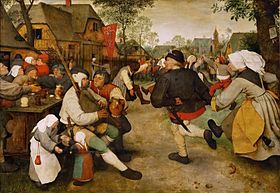
Genre painting,also calledgenre sceneorpetit genre,depicts aspects ofeveryday lifeby portraying ordinary people engaged in common activities. One common definition of a genre scene is that it shows figures to whom no identity can be attached either individually or collectively—thus distinguishingpetit genrefromhistory paintings(also calledgrand genre) andportraits.A work would often be considered as a genre work even if it could be shown that the artist had used a known person—a member of his family, say—as a model. In this case it would depend on whether the work was likely to have been intended by the artist to be perceived as a portrait—sometimes a subjective question. The depictions can be realistic, imagined, or romanticized by the artist. Because of their familiar and frequently sentimental subject matter, genre paintings have often proven popular with thebourgeoisie,ormiddle class.Genre themes appear in nearly all art traditions. Painted decorations in ancientEgyptiantombs often depict banquets, recreation, and agrarian scenes, andPeiraikosis mentioned byPliny the Elderas aHellenisticpanel painter of "low" subjects, such as survive inmosaicversions and provincial wall-paintings atPompeii:"barbers' shops, cobblers' stalls, asses, eatables and similar subjects".[2]Medievalilluminated manuscriptsoften illustrated scenes of everyday peasant life, especially in theLabours of the Monthsin the calendar section ofbooks of hours,most famouslyLes Tres Riches Heures du Duc de Berry.
To 1800
[edit]
TheLow Countriesdominated the field until the 18th century, and in the 17th century bothFlemish Baroque paintingandDutch Golden Age paintingproduced numerous specialists who mostly painted genre scenes. In the previous century, the FlemishRenaissancepainterJan Sanders van Hemessenpainted innovative large-scale genre scenes, sometimes including a moral theme or a religious scene in the background in the first half of the 16th century. These were part of a pattern of "Manneristinversion "inAntwerppainting, giving "low" elements previously in the decorative background of images prominent emphasis.Joachim Patinirexpandedhis landscapes,making the figures a small element, andPieter Aertsenpainted works dominated by spreads ofstill lifefood and genre figures of cooks or market-sellers, with small religious scenes in spaces in the background.Pieter Brueghel the Eldermade peasants and their activities, very naturalistically treated, the subject of many of his paintings, and genre painting was to flourish in Northern Europe in Brueghel's wake.
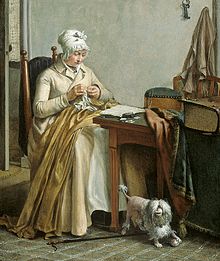
AdriaenandIsaac van Ostade,Jan Steen,Adriaen Brouwer,David Teniers,Aelbert Cuyp,Johannes VermeerandPieter de Hoochwere among the many painters specializing in genre subjects in the Low Countries during the 17th century. The generally small scale of these artists' paintings was appropriate for their display in the homes of middle class purchasers. Often the subject of a genre painting was based on a popularemblemfrom anemblem book.This can give the painting a double meaning, such as inGabriel Metsu'sThe Poultry seller,1662,showing an old man offering aroosterin a symbolic pose that is based on a lewd engraving by Gillis van Breen (1595–1622), with the same scene.[3]Themerry companyshowed a group of figures at a party, whether making music at home or just drinking in a tavern. Other common types of scenes showed markets or fairs, village festivities ( "kermesse" ), or soldiers in camp.
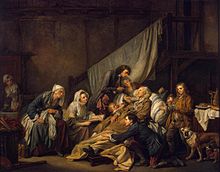
InItaly,a "school" of genre painting was stimulated by the arrival inRomeof the Dutch painterPieter van Laerin 1625. He acquired the nickname "Il Bamboccio" and his followers were called theBamboccianti,whose works would inspireGiacomo Ceruti,Antonio Cifrondi,andGiuseppe Maria Crespiamong many others.
Louis le Nainwas an important exponent of genre painting in 17th-century France, painting groups of peasants at home, where the 18th century would bring a heightened interest in the depiction of everyday life, whether through theromanticizedpaintings ofWatteauandFragonard,or the carefulrealismofChardin.Jean-Baptiste Greuze(1725-1805) and others painted detailed and rather sentimental groups or individual portraits of peasants that were to be influential on 19th-century painting.
In England,William Hogarth(1697–1764) conveyed comedy, social criticism and moral lessons through canvases that told stories of ordinary people full of narrative detail (aided by long sub-titles), often in serial form, as in hisA Rake's Progress,first painted in 1732–33, then engraved and published in print form in 1735.
Spain had a tradition predatingThe Book of Good Loveof social observation and commentary based on the Old Roman Latin tradition, practiced by many of its painters andilluminators.At the height ofthe Spanish Empireand the beginning of its slow decline, manypicaresquegenre scenes of street life—as well as the kitchen scenes known asbodegones—were painted by the artists of TheSpanish Golden Age,notablyVelázquez(1599–1660) andMurillo(1617–82). More than a century later, the Spanish artistFrancisco de Goya(1746–1828) used genre scenes in painting andprintmakingas a medium for dark commentary on the human condition. HisThe Disasters of War,a series of 82 genre incidents from thePeninsular War,took genre art to unprecedented heights of expressiveness.
19th century
[edit]

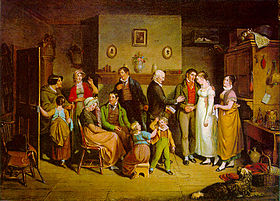
With the decline of religious and historical painting in the 19th century, artists increasingly found their subject matter in the life around them.Realistssuch asGustave Courbet(1819–77) upset expectations by depicting everyday scenes in huge paintings—at the scale traditionally reserved for "important" subjects—thus blurring the boundary which had set genre painting apart as a "minor" category.History paintingitself shifted from the exclusive depiction of events of great public importance to the depiction of genre scenes in historical times, both the private moments of great figures, and the everyday life of ordinary people. In French art this was known as theTroubador style.This trend, already apparent by 1817 whenIngrespaintedHenri IV Playing with His Children,culminated in thepompierart of French academicians such asJean-Léon Gérôme(1824–1904) andJean-Louis-Ernest Meissonier(1815–91). In the second half of the century interest in genre scenes, often in historical settings or with pointed social or moral comment, greatly increased across Europe.
William Powell Frith(1819–1909) was perhaps the most famous English genre painter of the Victorian era, painting large and extremely crowded scenes; the expansion in size and ambition in 19th-century genre painting was a common trend. Other 19th-century English genre painters includeAugustus Leopold Egg,Frederick Daniel Hardy,[4]George Elgar Hicks,William Holman HuntandJohn Everett Millais.Scotland produced two influential genre painters,David Allan(1744–96) andSir David Wilkie(1785–1841). Wilkie'sThe Cottar's Saturday Night(1837) inspired a major work by the French painterGustave Courbet,After Dinner at Ornans(1849). FamousRussianrealist painters likePavel Fedotov,Vasily Perov,andIlya Repinalso produced genre paintings.
In Germany,Carl Spitzweg(1808–85) specialized in gently humorous genre scenes, and in ItalyGerolamo Induno(1825–90) painted scenes of military life. Subsequently, theImpressionists,as well as such 20th-century artists asPierre Bonnard,Itshak Holtz,Edward Hopper,andDavid Parkpainted scenes of daily life. But in the context of modern art the term "genre painting" has come to be associated mainly with painting of an especially anecdotal or sentimental nature, painted in a traditionally realistic technique.
The first true genre painter in the United States was the German immigrantJohn Lewis Krimmel,who learning from Wilkie and Hogarth, produced gently humorous scenes of life in Philadelphia from 1812 to 1821. Other notable 19th-century genre painters from the United States includeGeorge Caleb Bingham,William Sidney Mount,andEastman Johnson.Harry Roseland[5]focused on scenes of poor African Americans in the post-American Civil WarSouth,[6]andJohn Rogers(1829–1904) was a sculptor whose small genre works, mass-produced in cast plaster, were immensely popular in America. The works of American painterErnie Barnes(1938–2009) and those of illustratorNorman Rockwell(1894–1978) could exemplify a more modern type of genre painting.
Genre in other traditions
[edit]Japaneseukiyo-eprints are rich in depictions of people at leisure and at work, as areKoreanpaintings, particularly those created in the 18th century.
Gallery of Flemish genre paintings
[edit]-
Jan Sanders van Hemessen,Brothel scene,c. 1545–1550.
-
David Teniers the Younger,Tavern scene,1640.
-
Joos van Craesbeeck,Soldiers and Women,1640s
Gallery of Dutch 17th-century genre paintings
[edit]-
Hendrick Avercamppainted almost exclusively winter scenes of crowds.
-
Gerard van Honthorst,Merry Company,1623, with thechiaroscurocomposition often used by theUtrecht Caravaggists.
-
Judith Leyster,A Boy and a Girl with a Cat and an Eel,c. 1635
Genre photography
[edit]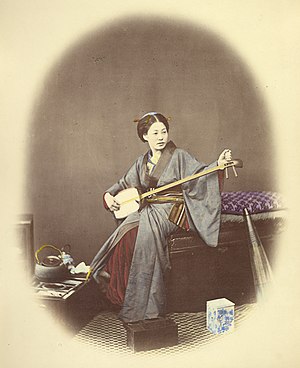
While genre painting began, in the 17th century, with representations by Europeans of European life, the invention and early development of photography coincided with the most expansive and aggressive era of European imperialism, in the mid-to-late 19th century, and so genre photographs, typically made in the proximity of military, scientific and commercial expeditions, often also depict the people of other cultures that Europeans encountered throughout the world.
Although the distinctions are not clear, genre works should be distinguished fromethnographic studies,which are pictorial representations resulting from direct observation and descriptive study of the culture and way of life of particular societies, and which constitute one class of products of such disciplines asanthropologyand thebehavioural sciences.
The development of photographic technology to make cameras portable and exposures instantaneous enabled photographers to venture beyond the studio to follow other art forms in the depiction of everyday life. This category has come to be known asstreet photography.[7][8][9]
See also
[edit]Notes
[edit]- ^Art & Architecture Thesaurus, s.v. "genre"Archived2018-07-31 at theWayback Machine.Accessed 2 November 2006.
- ^Book XXXV.112 ofNatural History
- ^"E. de Jongh, 'Erotica in vogelperspectief. De dubbelzinnigheid van een reeks zeventiende-eeuwse genrevoorstellingen'".DBNL.Retrieved16 March2018.
- ^Hardy, Kimber (2016).The Hardy Family of Artists: Frederick Daniel, George, Heywood, James and their descendants.Woodbridge, Suffolk UK: ACC Art Books. pp. 12–63.ISBN978-185149-826-0.
- ^Canu, John F."ART / 4 / 2DAY".safran-arts.Retrieved16 March2018.
- ^Schatzki, Stefan C. (May 1992)."Visit from the Doctor-A Serious Case".American Journal of Roentgenology.158(5): 970.doi:10.2214/ajr.158.5.1566698.PMID1566698.
- ^Bystander: A History of Street PhotographybyJoel MeyerowitzandColin Westerbeck,Boston:Bulfinch Press,1994.ISBN0-82121-755-0.Boston: Bulfinch Press, 2001.ISBN9780821227268.
- ^The Sidewalk Never Ends: Street Photography Since the 1970sby Colin Westerbeck, Chicago:Art Institute of Chicago,2001.
- ^Street Photography Nowby Sophie Howarth and Stephen McLaren, London:Thames & Hudson,2010.ISBN978-0-500-54393-1"Thames & Hudson Publishers | Essential illustrated art books | Street Photography Now".Archived fromthe originalon 2010-10-03.Retrieved2010-10-09..
References
[edit]- Ayers, William, ed.,Picturing History: American Painting 1770-1903,ISBN0-8478-1745-8
- Banta, Melissa. 'Life of a Photograph: Nineteenth-Century Photographs of Japan from the Peabody Museum and Wellesley College Museum'. InA Timely Encounter: Nineteenth-Century Photographs of Japan(ex. cat.; Cambridge, Massachusetts: Peabody Museum Press, 1988), 12.
- Banta, Melissa, and Susan Taylor, eds.A Timely Encounter: Nineteenth-Century Photographs of Japan(ex. cat.; Cambridge, Massachusetts: Peabody Museum Press, 1988).






